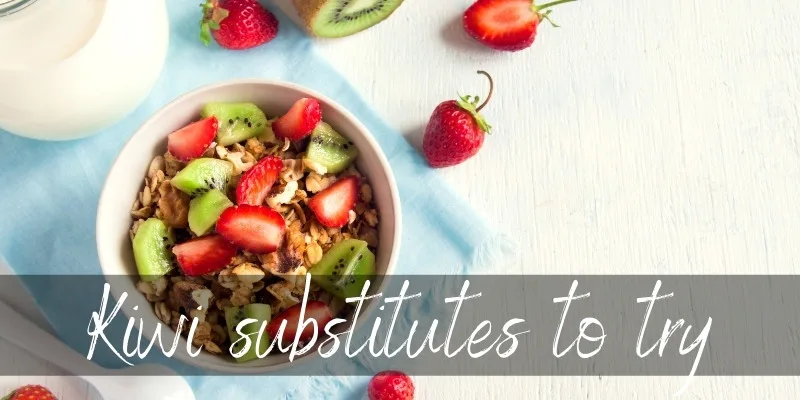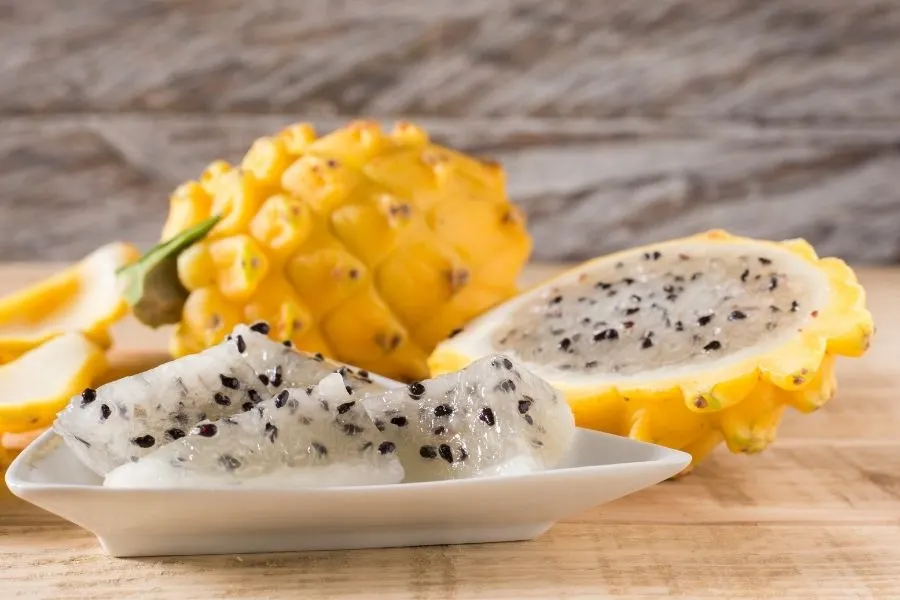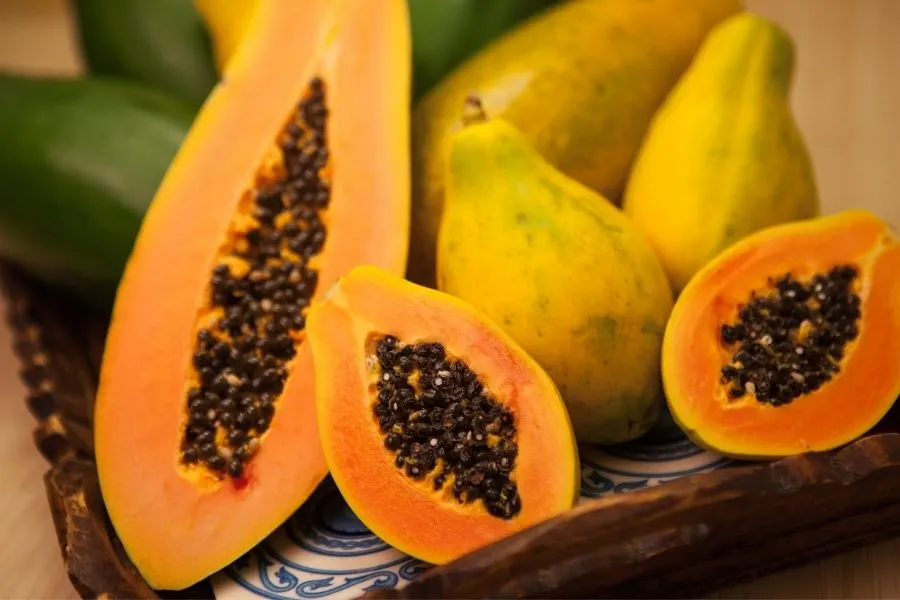Whether you’re making the world’s best Pavlova or just a fruit salad, you may or may not have fresh kiwi on hand. These fuzzy potatoes (as we call them) are amazing but not always available.
And sometimes that can get downright expensive ! There’s good reasons for that, of course. But if you can’t afford kiwi right now, or can’t find any, you’re going to need a substitute.
So this is what we’ll be covering today. We’ll talk about kiwi substitutes for desserts or salads, a set of substitutes that are exotic but will work great, and some vitamin C-packed fruits as well. We’ve got something for everyone, so read on !

Best kiwi substitute
The absolute best kiwi substitute is strawberry with a little bit of lime juice. Similar texture, small seeds, and flavor. Other options are fresh ripe pear with a bit of lemon or lime juice, and dragon fruit for the kiwi-like appearance.
Neither of these is exactly like kiwi, but of al the substitutes that coms the closest. We’ll walk you through how to sue each, and then touch on the more exotic ones in another section. After all, if you don’t have kiwi and your recipe can be flexible, you could swap out the fruit entirely !
But first let’s see the kiwi substitutes.
Fresh strawberry with lime juice
Fresh strawberries have that sweet, slightly tart perfume that seems to go with everything. More importantly, they’re soft and very similar to kiwi in texture. They even have small seeds, just like a kiwi, so they’ll blend in just right.

The only problem is that you may have to add a dash of lime or lemon juice to make it more tart. Other than that the flavor is pretty similar to kiwi, and strawberries will work very well.
They’re soft and cut very easily, so any dessert should be stable.
Read also: Is Kiwi A Citrus Fruit ?
Pear with a little citrus (lemon or lime)
Another option would be to use a very ripe pear for the texture and sweetness. Pears are a little grainy, which may mimic the seeds in kiwi and the softness fairly well.
But you definitely need to add lemon or lime, because pears tend to be very sweet compared to kiwis. Again, remember to get ripe, sweet pears. An underripe pear will be tough and won’t really work for this.
Dragon fruit for appearance
Pitaya or dragon fruit is noted for its soft texture and tiny, black seeds scattered throughout the flesh. In terms of flavor pitayas are much blander than a kiwi, and if you want a good one you need to look for the yellow ones.

If you can’t find yellow pitaya, try looking for the red skin and red flesh ones. These two are generally sweeter.
Dragon fruit is a little tart, less so that kiwi. But in terms of appearance it’s the closest you can get. If your dessert absolutely needs to look like it has something like kiwi, go for dragon fruit.
All this being said, keep in mind that you can always get a little green food coloring to further ‘fake’ a kiwi.
Exotic kiwi substitutes
Alright, you have no kiwi and the above substitutes don’t sound all that good to you, or maybe you can’t find them. Alright, there’s other things you can use instead of kiwi.
If your recipe doesn’t call for kiwi specifically, just a sweet and tart fruit, then you can opt for another fruit. The final flavor won’t be the same, that’s true, but it’s a nice twist on a classic.
For example if you’ve always made your Pavlova with kiwis, why not swap for pineapple or papaya ? Let’s explore a few options.
Carambola or star fruit
This yellow star-shaped beauty is bound to make your dessert stand out. It’s somewhat sweet, slightly similar to plums, gooseberries, or mirabelles.
A good star fruit will be yellow and waxy, and will slice beautifully. And yes, the skin is edible too !
Pineapple
Pineapple gives an instant tropical vibe to everything, and is incredibly sweet and delicious too ! Whether you get fresh pineapple or canned, chop it into small cubes, and sprinkle it all over a salad or dessert.
If you’re aiming for a nice presentation, get canned pineapple slices. They’re little circles that can be used as-is, or sliced in half and used as half-moons.
And if you get a good batch they’ll be very soft and easy to slice through !
Mango
A good mango may be a little tricky to find but it’ll turn everyone’s heads. It’s miles away from kiwi’s flavor, but it’s definitely something to try out. That sweet, slightly musky and citrusy flavor is pretty much unbeatable.
If you live in a very warm climate then a good mango may be easier to find than we estimate, so go for it !
Papaya
Papayas are delicious and they look damn amazing ! You can even use their black seeds too, just don’t overdo it. Compared to other flavors on this list papaya is a little mellow. But if you find a perfectly ripe one it’ll turn out great.

Persimmon
Yet another tropical and exotic fruit, persimmon is going to pop against some delicious whipped cream, or it can even be added to chocolate-based desserts !
It’s relatively sweet and tart, meaning it won’t take over your dessert as a pineapple or mango would. Still, it’s a nice change from the usual fruits used for desserts.
Read Also:How To Store Kiwi To Make It Last Longer
Fruits high in vitamin C
If you were looking for kiwi because you need a boost of vitamin C, don’t worry because there are other fruits that can come close. While 100 gr of fresh kiwi packs a whopping 92.7 mg of vitamin C, it’s not the only one with a big punch. True, no other fruit can punch as hard but they come fairly close. Some of them outdo lemons (53 mg) or oranges (53.2 mg) !
Clementines – 48.8 mg of vitamin C for 100 gr of fruit. These fruits are best eaten raw, and on their own. Sit down with a bag of clementines and you won’t notice when you’ve already peeled and eaten 6 of them. They’re small, easy to peel, and sometimes even taste better than oranges.
Pineapple – 47.8 mg of vitamin C for 100 gr of fruit. Not only are they delicious, but they pack a lot of vitamin C. Talk about convenient ! We recommend going for the fresh version, and cutting it on your own. Canned pineapple is pre-cut and may have lost some vitamin along the way.
Strawberry – 58.8 mg of vitamin C for 100 gr of fruit. They were on this list from the very beginning, and if you add a little bit of lime juice (29.1 mg of vit. C) you’re boosting your vitamin intake !
Papaya – 60.9 mg of vitamin C per 100 gr fruit. If that’s not enough to convince you to give papaya a try instead of kiwi, we don’t know what would.
Persimmon – 66 mg of vitamin C per 100 gr of fruit. Okay, it’s starting to sound like a lot of orange-yellow-red fruits are packed with vitamin C. Persimmon is fairly easy to eat and you can even eat the outer skin !
Orange – 53.2 mg of vitamin C for 100 gr of fruit. Oranges are more of a winter treat, but they can be found in the summer too. As with clementines we recommend just sitting down with a couple of oranges and eating them on their own.
When you’re done you can keep the peels for a few hours to get your home smelling like Christmas. You can also do this with clementine peels, too. And if you’re planning on making mulled wine, don’t throw away the peels ! Grate or cut off the outer part, the zest, and add it to the wine spices.
And that’s it about kiwi substitutes. As you can see there’s a lot of directions you can go in if you want to substitute kiwi. Whether you’re looking for a perfect substitute or just want another fruit, we hope this list helped you out.

